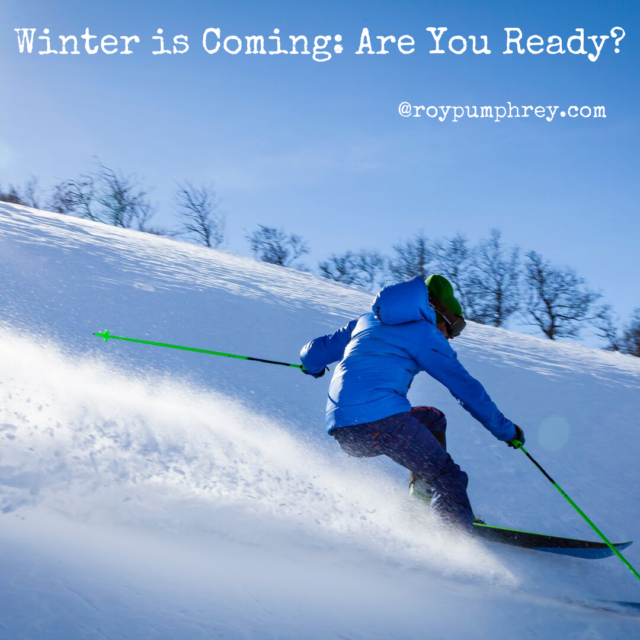
I Have NEVER Skied.
Fun Fact:
I train a whole bunch of skiers.
More Fun(er) Fact:
They don’t need “Ski Specific” training to improve.
People that sell you “sport specific” are often charlatans who don’t actually know what sports specific means.
And NO sport specific DOES NOT mean the movement kinda sorta LOOKS like the sporting movement.
Sport Specific:
For an exercise to be classified as “sport specific” it MUST, in the same motor regime, accurately replicate similar joint angle velocities as the sporting movement its self.
Most Fun Fact:
In my experience, the “training” most skiers (and weekend warriors as a whole) do, isn’t training at all.
It’s exercise.
And it’s doing very little to actually improve their ski capabilities.
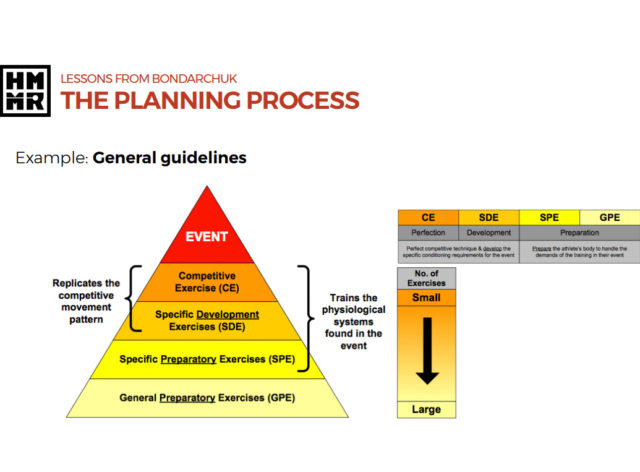
taken from lessons from Bondarchuck
How Do You Know, If You’ve Never Skied?
Here’s the fun thing about biomechanics.
They are what they are.
Physics IS.
Issac Newton ALWAYS wins.
The SPORT doesn’t matter, what happens during the sport matters.
“I Don’t Do Sport Specific, I do HUMAN Specific”- Kelly Starrett
What Are the Physical Needs Of the Skier?
High level skiing requires EVERYTHING physiologically to be proficent,
“Perhaps the most important understanding gained from investigation into the physiology of ski racing is that no single physiological variable can be identified as being more important than another. Whilst technical ability appears the greatest influencing factor, the ability to continually exhibit technical competence through a long competitive season requires high capabilities within all physiological systems, and the complex integration of training all these systems together should remain the focus of the sport scientists input.” – Physiology of Alpine Skiing
these physiological capabilities include:
- Aerobic endurance
- Aerobic power
- Anaerobic power
- Muscular strength
- Muscular endurance
- Mobility
But what about this line,
“technical ability appears the greatest influencing factor”
Training doesn’t do as much as meatheads like me would like to think it does, right?
Just get better skis and your boots adjusted and you’re good to go, right?
WRONG
Your technique is only as proficient as your physical abilities allow it to be.
“Underdevelopment of motor abilities undoubtedly has a certain negative influence on success while acquiring skiing technique elements. Focused exercises not done in ski field can influence development of the motor abilities which are particularly employed while skiing. Moreover, it is possible to influence the significant motor abilities important for skiing by doing specific body activities. ….Pedagogues, teachers and instructors should know ways and methods for teaching skiing. But when they teach specific ski movements they should respect motor abilities influence on that process. Therefore, recreational skiers or the future ones are recommended to have proper fitness motor preparation before going in ski fields” – INFLUENCE OF MOTOR ABILITIES ON LEARNING OF ALPINE SKI TECHNIQUE
Long story short:
If your body (physical abilities) can’t achieve certain body positions and movements,
YOU WONT BE ABLE TO DISPLAY THOSE MOTOR ABILITIES TECHNICALLY.
“Elite skiers attempt to exploit these intricate interactions between biomechanical parameters and technique under varying conditions in a manner that minimizes descent times.” – Recent Kinematic and Kinetic Advances in Olympic Alpine Skiing: Pyeongchang and Beyond
Here’s the good news,
You don’t need to be a super star in any of these physical qualities to be an elite skier,
“alpine ski racing challenges virtually all of an athlete’s physical capacities, including strength (maximal strength, strength endurance, and stability), power, aerobic and anaerobic capacity, balance, coordination and motor control, and mobility. At the same time, these challenges are not extreme in terms of human capacity and athletes with substantially different physical characteristics can all compete at a high level.“- The Training of Olympic Alpine Ski Racers
But you need to be “good enough” in all of them.
And here’s the rub for most people with day jobs.
Good enough, at high levels of skiing, is still pretty damn good
Probably better than where you are right now.
“Peak ground reaction forces, which can be as high as five times body weight” – Recent Kinematic and Kinetic Advances in Olympic Alpine Skiing: Pyeongchang and Beyond
Just Tell Me What The Hell to Do:
These are in no particular order what I tend to prioritize with my skiers:
#1: Movement Quality
You need to move better.
Skier’s tend to need 3 things:
- Toe and ankle mobility
- Hip mobility
- Low back stability/ pelvic/ core control
In reality #2 and #3 are intimately related.
Toe and Ankle Mobility
Is lacking, as a whole, in the general public, but I guess being stuck in ski boots and one too many cases of frostbite steals your toe and ankle mobility more than most.
To ski effectively your toes and ankles MUST move freely because precise foot pressure changes and ankle dorsi and plantar flexion play a critical role in adjusting the angle and maintaining the edging of the skis in high level skiing.
” Feet are a body part which is critical to this sport. They are responsible for receiving sensory stimuli from the ground through the skis and boots and for precise distribution of pressure on the equipment. In beginner skiers, this process is disturbed. Therefore, from the viewpoint of coaching skiing, it is essential to determine the effect of considerable limitation in ankle joint mobility caused by wearing ski boots on the level of postural stability of a skier.” – Body Posture Stability in Ski Boots Under Conditions of Unstable Supporting Surface .
Improve Your Toe and Ankle Mobility:
The simplest thing to do is walk around barefoot as much as possible.
NO, flip flops are not barefoot.
They actually make the foot mobility problem worse.
Easy exercises like:
- Towel Crunches:
- Toe Spreads:
- Rooting or short foot:
- Ankle Mobs:
- Ankle Alphabet
Are all super easy, can be done all through the day, everyday.
Hip Mobility:
Just like everyone else in society, my skiers tend to have craptastic hip mobility.
They tend to preferentially move from the knee and low back instead of hinging through the hips.
“To feel where this joint flexes, lift one knee off the ground while keeping your spine neutral. Note where the crease in your leg occurs after flexing. If you have pockets on the front of your pants, the crease may be across the top of your pockets. Feel around and notice that the bony area often referred to as “the hips” is found above this crease. This bony ridge is actually the crest of your pelvis – this crest does not correspond to your hips! I point this out because many skiers will flex their lower backs when cued to bend their hips. Instead of flexing at the true hip joint, they fold nearer to their belly buttons.” – Snowbrains.com
Do You Hinge or Round?
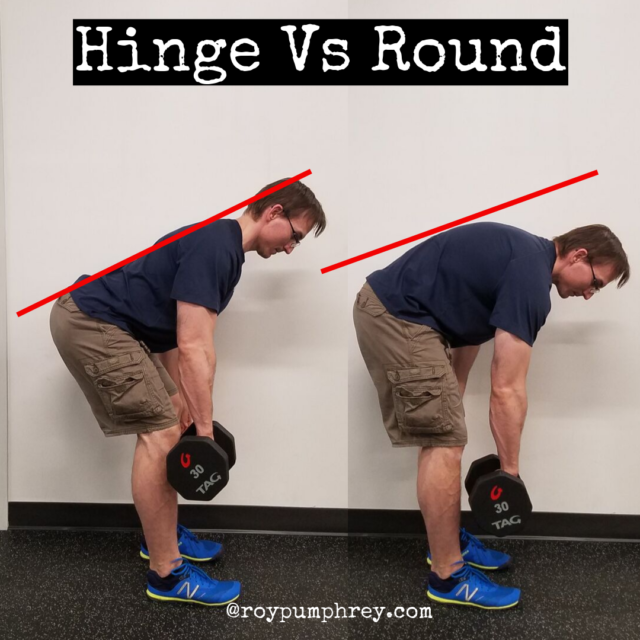
This is both a byproduct of modern life and the ski posture with its rounded thoracic spine, posteriorly tilted pelvis and stiff ankles.
This posture usually results in:
- An overactive low back (spinal erectors)
- Excessive psoas activation and hip flexor tightness
- Weak glutes and obliques
A Lack Of Core/ Pelvic Control
Crunching down, pulling the ribcage to the pelvis, creating more tension IS NOT CORE CONTROL.
Core control is about maintaining an optimal core/ pelvis position (which is usually neutral) in respect to the forces acting on the body.
If you maintain a neutral pelvis/ spine the core will stiffen on its own when compressive and hoop forces are applied to the extremities.
Bird Dogs:
Suitcase Marching:
Mountain Climbers:
The key to all of these movements is to maintain a neutral pelvis the entire time.
If the belt buckle tilts toward the chin and the low back rounds, you’re core isn’t doing what it needs to, creating stability transferring force.
Instead, you’re core is acting as a primary mover.
#2: Strength
Especially isometric/ eccentric strength and on one leg,
“carved turn is a prolonged eccentric component and the sport requires the absorption of terrain, which is primarily accomplished through eccentric muscle action, the idea of eccentric dexterity to describe this may have its origins with a preliminary finding from Hoppeler and Vogt, who showed that the ability to more finely modulate eccentric force had a very strong correlation (r = 0.93) with percent standard deviation for target eccentric cycling force during a 20-minute effort to whole-season SL FIS points, in a group of 15 elite junior alpine skiers. In other words, athletes who could more accurately adjust the level of eccentric force to a dynamic target wattage reading output on the eccentric ergometer computer were also subsequently ranked as better SL athletes using a FIS point list—an international skiing sport ranking system. Interestingly, it has been shown in GS skiing that approximately 1.0 ± 0.2 seconds is spent in eccentric muscle action of the quad, with only 0.5 ± 0.1 seconds spent in concentric muscle action. Providing evidence that a skier can finely adjust ground force reactions against the snow during eccentric movement is a highly important skill for ski racing success.” – Review of Strength and Conditioning for Alpine Ski Racing
Here’s the best part with this, you can VERY effectively train eccentric control by:
- Slowing down the lowering portion (eccentric) of the lift
- Pausing on the bottom. While the pause is an isometric, no one loses tension lowering when they have to pause.
- Lifting against band tension <—-not for beginners
- Using overload eccentrics (This works best with singles and a partner)
For most people, you don’t need specialized eccentric focused exercises.
Just pay attention to the lower portion of the exercise as much as the lifting.
Don’t relax/ bounce/ unload tension and drop into the bottom and you’ll be fine.
The vast majority of your “eccentric specific” training will occur once you’re actually on the mountain and actually sliding down the hill.
#3: Femur External Rotation
Just about everyone is terrible at this, and my skiers are no exception.
The thing is, External Rotation of the Femur is CRITICAL for ski performance.
It’s literally how you turn, you can’t ski well and not be proficient at independent, clean, internal and external rotation of the femur.
In my experience internal rotation ability is rarely lacking, and external rotation is faked through a combination of hip abduction, femur internal rotation and ankle inversion.
Using My Hip External Rotators?
If your IT band is jacked up all the time and/ or you have a hypertrophied Tensor Fascia Latae (TFL) you’re probably not.
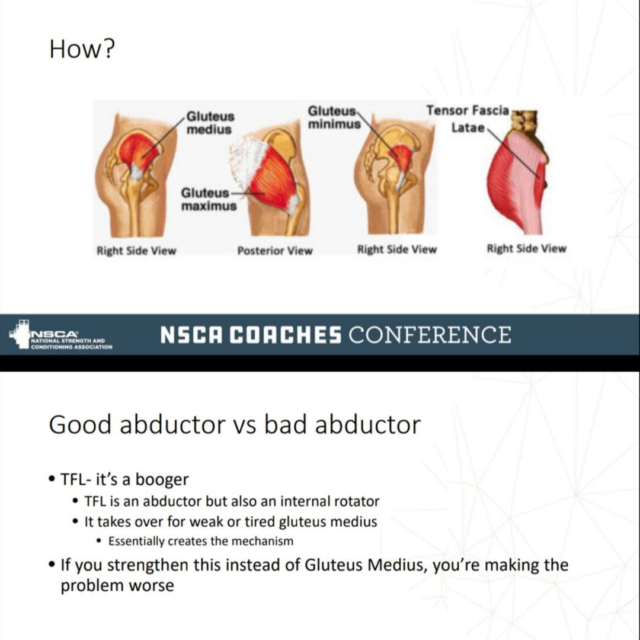
from Dr. Bryan Mann 2018 NSCA Coaches Conference.
Mini band Walks:
The most general rule of thumb here is the knee/ foot and ankle should never collapse into the midline during an exercise.
Always strive to maintain an arch in the foot, toe- ankle- knee-hip alignment, and in the words of the GOAT, Ed Coan,
“Open the Taint”
The One Best Exercise for Skiers?
First off, that’s a terrible question that totally pisses me off when people ask it.
Why?
Because when people ask that, they’re asking “how can I do the least amount of work possible yet achieve the great results”.
Well, you can’t.
You can achieve the greatest result by doing the necessary amount of work, however much that is (its usually not the least and its typically a bunch of stuff you really suck at).
Secondly, you’re most likely going to need several different exercises to optimize movement abilities, strengthen weaknesses and balance out muscle groups.
Why Try and Boil it Down to One Exercise?
When you can do any and all of them.
Keep in mind, this is NOT meant, in any way, to be a list of “the best ski exercises”.
Or even ones you should do.
I don’t know what YOU should do.
You need to take an HONEST, UNBIASED look at your strengths and weaknesses and make that determination.
Exercises that could be total money for someone else could totally suck for you.
There are NO Best Ski Exercises.
And a lot of what you see as “Ski Specific” on instagram and blogs?
It’s usually hype.
And constitutes a very small part of a pro skiers overall plan.
It ain’t the meat and taters.
And when you’re only training for 2-3 hours a week?
You need LOTS of meat and taters.
Very little sugar and spice.
While I’m sure, in general, some exercises transference to skiing is higher than others, there is interindividual variability present always.
Therefore, NO WAY to blindly know what exercises are appropriate for you, at what load, right now.
Try to figure out where YOUR weaknesses are and try exercises that attack those weaknesses.
Don’t worry about replicating skiing.
You can practice skiing,
SKIING ON THE MOUNTAIN
PS: Things I Forgot to Include
Unilateral Training
When in doubt opt for unilateral (single leg and arm) training when possible.
Disassociation between right and left legs is CRITICAL.
Most people are pretty poor at it and unilateral training helps to improve it.
Plus, single leg training generally trains more hip/ core coordination.
Power Training:
Is nice, but most recreational skiers will develop MORE than enough power simply by getting stronger.
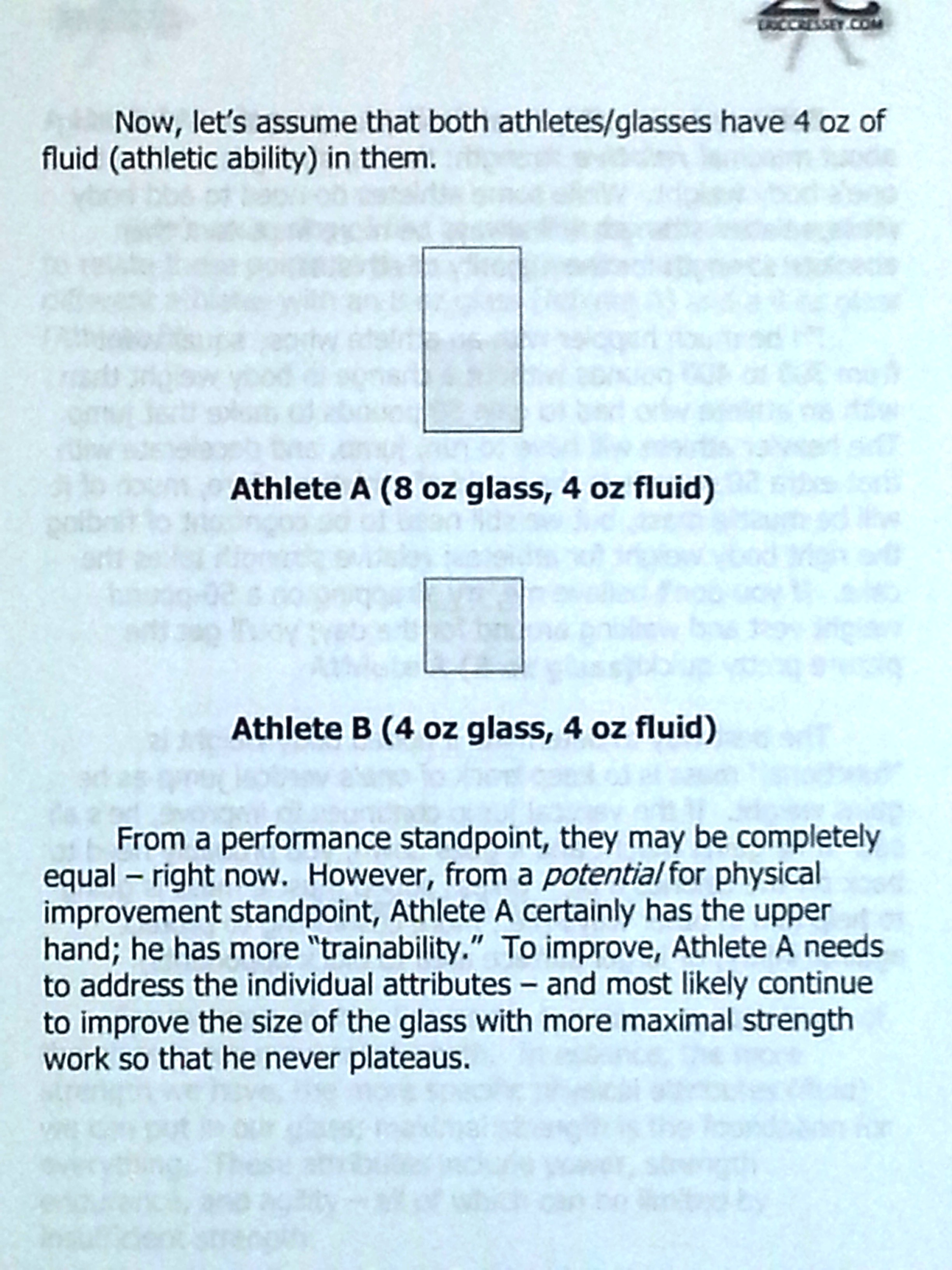
from Eric Cressey Ultimate Offseason Handbook.
Think of the size of the glass as maximal strength and fluid as power output. Power is always limited by your maximal strength.
If you’re actually pretty strong (legit squat 1.5 times bw) and already have good eccentric strength, have at it, try some dedicated power training.
Just keep the volume low.
When in doubt I like 3 sets of 5 or 5 sets of 3, with at least 3 minutes between sets.
- Broad Jumps
- Jump Squats
- Lunge Stance Jumps
- Depth Jumps
- Single and Double Leg Vertical Jumps.
*This is not to say that people with below 1.5X’s BW squats can’t benefit from things like cone hops, box jumps, low landings etc.
It’s to say that those really wont train power so much as coordination and eccentric motor control in most people.
And those are still really good things to train, your power output just might not improve as much as you think until you have the requisite strength base.
Unstable Surfaces:
Balance is surface dependent.
That means balancing on an inflatable disk wont necessarily transfer to skis on snow.
Plus, unstable surface training decreases force output thereby limiting strength gains.
Spending time training on unstable surfaces is a WASTE of time for most recreational athletes most of the time.
But not all, all the time….so make sure when you choose any exercise, unstable surface, unilateral, whatever, that the exercise trains the physiology you’re intending to train.


